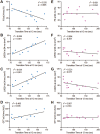Physical Resilience as a Predictor of Lifespan and Late-Life Health in Genetically Heterogeneous Mice
- PMID: 37701988
- PMCID: PMC10733175
- DOI: 10.1093/gerona/glad207
Physical Resilience as a Predictor of Lifespan and Late-Life Health in Genetically Heterogeneous Mice
Abstract
Dynamic measures of resilience-the ability to resist and recover from a challenge-may be informative of the rate of aging before overt manifestations such as chronic disease, disability, and frailty. From this perspective mid-life resilience may predict longevity and late-life health. To test this hypothesis, we developed simple, reproducible, clinically relevant challenges, and outcome measures of physical resilience that revealed differences between and within age groups of genetically heterogeneous mice, and then examined associations between mid-life resilience and both lifespan and late-life measures of physiological function. We demonstrate that time to recovery from isoflurane anesthesia and weight change following a regimen of chemotherapy significantly differed among young, middle-aged, and older mice, and were more variable in older mice. Females that recovered faster than the median time from anesthesia (more resilient) at 12 months of age lived 8% longer than their counterparts, while more resilient males in mid-life exhibited better cardiac (fractional shortening and left ventricular volumes) and metabolic (glucose tolerance) function at 24 months of age. Moreover, female mice with less than the median weight loss at Day 3 of the cisplatin challenge lived 8% longer than those that lost more weight. In contrast, females who had more weight loss between Days 15 and 20 were relatively protected against early death. These data suggest that measures of physical resilience in mid-life may provide information about individual differences in aging, lifespan, and key parameters of late-life health.
Keywords: Anesthesia; Chemotherapy; Frailty; Healthspan; Stress.
© The Author(s) 2023. Published by Oxford University Press on behalf of The Gerontological Society of America. All rights reserved. For permissions, please e-mail: journals.permissions@oup.com.
Conflict of interest statement
None.
Figures





Similar articles
-
Negative effects of lifespan extending intervention on resilience in mice.PLoS One. 2024 Nov 21;19(11):e0312440. doi: 10.1371/journal.pone.0312440. eCollection 2024. PLoS One. 2024. PMID: 39570905 Free PMC article.
-
Psychological resilience in older adults with type 2 diabetes from the Look AHEAD Trial.J Am Geriatr Soc. 2023 Jan;71(1):206-213. doi: 10.1111/jgs.17986. Epub 2022 Oct 5. J Am Geriatr Soc. 2023. PMID: 36196673 Free PMC article. Clinical Trial.
-
A cross-sectional study of male and female C57BL/6Nia mice suggests lifespan and healthspan are not necessarily correlated.Aging (Albany NY). 2016 Oct 2;8(10):2370-2391. doi: 10.18632/aging.101059. Aging (Albany NY). 2016. PMID: 27705904 Free PMC article.
-
Resilience in Clinical Care: Getting a Grip on the Recovery Potential of Older Adults.J Am Geriatr Soc. 2019 Dec;67(12):2650-2657. doi: 10.1111/jgs.16149. Epub 2019 Sep 9. J Am Geriatr Soc. 2019. PMID: 31498881 Free PMC article. Review.
-
Energetic interventions for healthspan and resiliency with aging.Exp Gerontol. 2016 Dec 15;86:73-83. doi: 10.1016/j.exger.2016.05.012. Epub 2016 May 31. Exp Gerontol. 2016. PMID: 27260561 Free PMC article. Review.
Cited by
-
Negative effects of lifespan extending intervention on resilience in mice.PLoS One. 2024 Nov 21;19(11):e0312440. doi: 10.1371/journal.pone.0312440. eCollection 2024. PLoS One. 2024. PMID: 39570905 Free PMC article.
-
Editorial: Clinical uses and alternative approaches of frailty determination.Front Physiol. 2025 Apr 11;16:1575742. doi: 10.3389/fphys.2025.1575742. eCollection 2025. Front Physiol. 2025. PMID: 40342861 Free PMC article. No abstract available.
References
-
- Weintraub WS, Craver JM, Cohen CL, Jones EL, Guyton RA.. Influence of age on results of coronary artery surgery. Circulation. 1991;84:III226–III235. - PubMed
Publication types
MeSH terms
Grants and funding
LinkOut - more resources
Full Text Sources
Molecular Biology Databases

